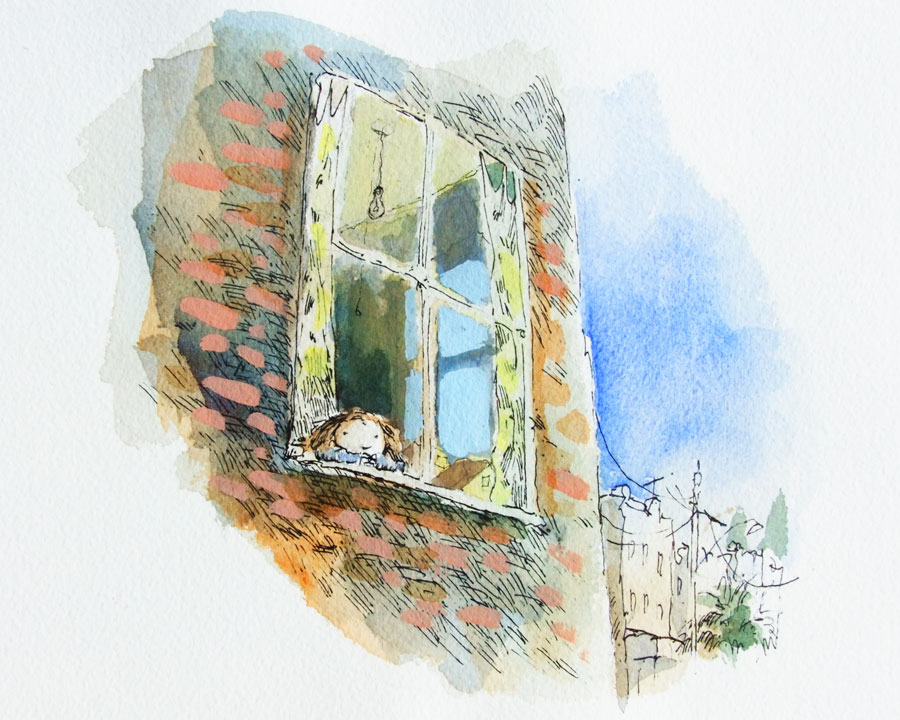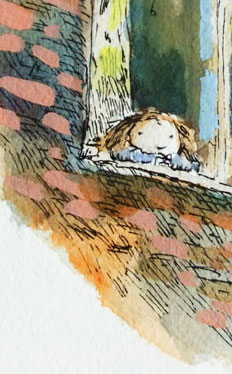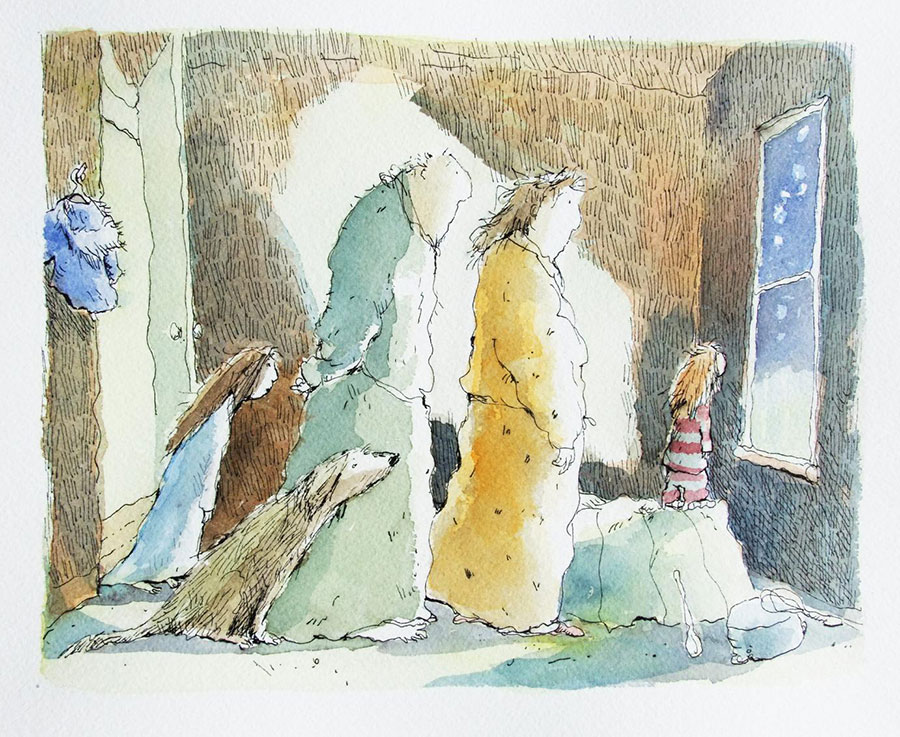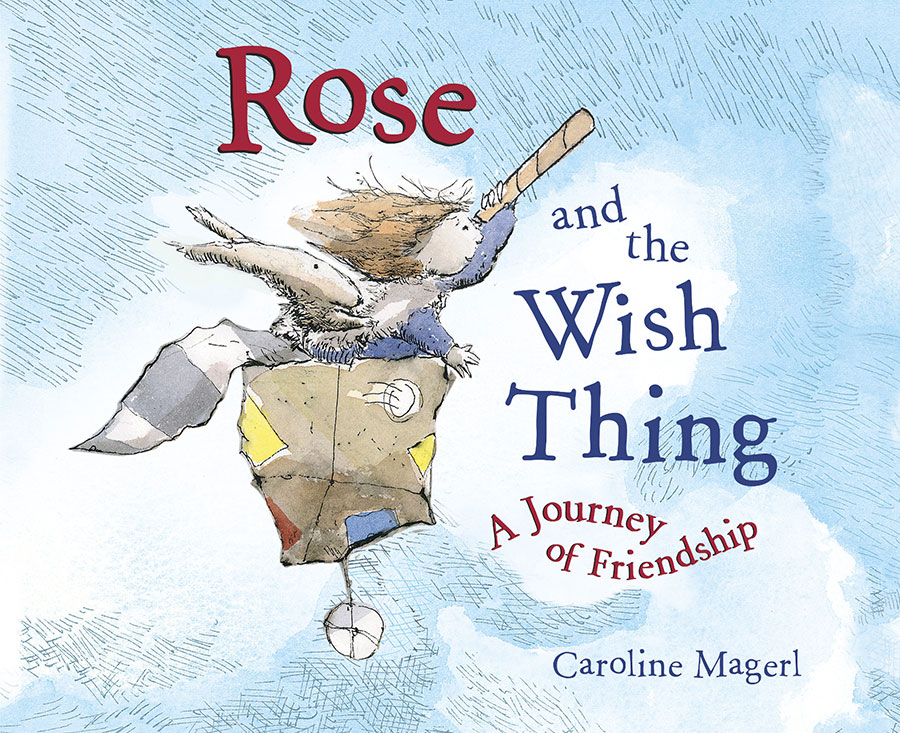In this installment of The Writer’s Journey, celebrated author, illustrator and CWG Contributor Caroline Magerl takes readers into the creative process for her latest work, Rose and the Wish Thing.

“Rose was a new face in a new street”
This picture, this place, this girl; her feet are not on the ground, she is in a space that is not hers. You are looking up at her in a large building… in a sense she is hanging onto the window sill, a floating feeling between a window in and a window out. There she hangs onto something, but it is not what she needs. To give the impression of loneliness, of being somewhere that was not home, I had a strong intuition to create a vignette as a floating image; a window into the story. It’s fleeting and you aren’t meant to dwell, its intention is to lead you into the story.
Watercolor was the obvious choice of medium. It was the first medium I saw in books as a child. I was fascinated by the simultaneous impression of overall harmony, and yet it was plain to see that that the image was built up in films and layers of color. It had the ability to be evocative and loose, but also describe things in minute details. I didn’t know how it was done, only that it could be done and that there was great skill in doing so. I became obsessed with it and eventually taught myself.
This picture as with the rest of the story has a consistent palette which helped to maintain an underlying harmony. A very pale yellow was applied beneath all the images, which provided a sense of warmth throughout. The yellow is a very clear color which manages to glow through the many layers which were laid over. I had great delight in floating the opaque bricks in mid air against the wall, where they sit almost magically against the building. The blue sky and red bricks are reminiscent of my early impressions of Sydney, where as a child; I was a new face in a new street. Leaving Europe where the sky covered as a blanket over the world, my new town appeared with a sense of blue immensity. For me, red and blue are emotionally charged colors.

Part of the visual narrative in this picture is the distant streetscape. This created a neighborhood atmosphere which is a major part of the story; there was something to be gained out there, something for Rose to gain, a promise of something. It wasn’t just Rose in a window; it was also an overlay of meaning and an unspoken agenda. Pictures have a very powerful role in telling the unspoken aspects of a story. Its language is in the color, tonal value, perspective, proportions, expression, and in this case an understated yet obvious element, ‘a new street’.
Loose line work creates a spontaneous joy. There is a sense of exploration as the strokes create new vegetation, random birds, etc. They spring forward in the most charming way, but do come with the enormous risk of irreversibility. Line work reads beautifully and you can feel the energy of the person who drew it.
It was important that the text had a musical beat. The aim was to create a story that conveyed meaning but also satisfied in the reading, almost like a piece of music; a rhythmic element with rise and fall and pauses. That musical sense carries from reader to child in what is really a little bit of theatre, namely storytime.
Obliqueness in the writing offers up the chance to read a story in an individual way; to explore its different aspects. The act of reading should be a shared experience between all involved. The indirect approach invites the reader in, and once there, offers the chance to explore and decide for themselves what to take from a story. By avoiding a bald faced telling, the story has a longer life; there is something to think about later, something the reader can come to … in their own time. The aim is to relate and reach someone, not to dictate a lesson and thereby be dismissed. For my part, being a fine artist has taught me to rely on underlying intention; it carries the work through and lets me maintain a light touch. This has been my experience, and it is a principle I hold to in my work.

It was a difficult beginning in this book … initially I had strong prose; “The Wish Thing arrived in a tired Brown Box.” However I struggled to find the way forward. In a moment of frustration, I began another story about a child named Rose and it soon became apparent these were two aspects of the same story. Ironically the story about two things coming together grew from two stories intertwining. So it came to pass that “The Wish Thing arrived in a tired brown box” found its rightful place inside the story and now we first meet Rose as “the new face in a new street.”
When touching on serious subjects, it’s best to acknowledge the truth.
The gift is in the message, “that you can live through this… like others before you.” For the message to be positive, it has to be emotionally honest, a lived experience that is felt and understood.



 Caroline Magerl
Caroline Magerl 